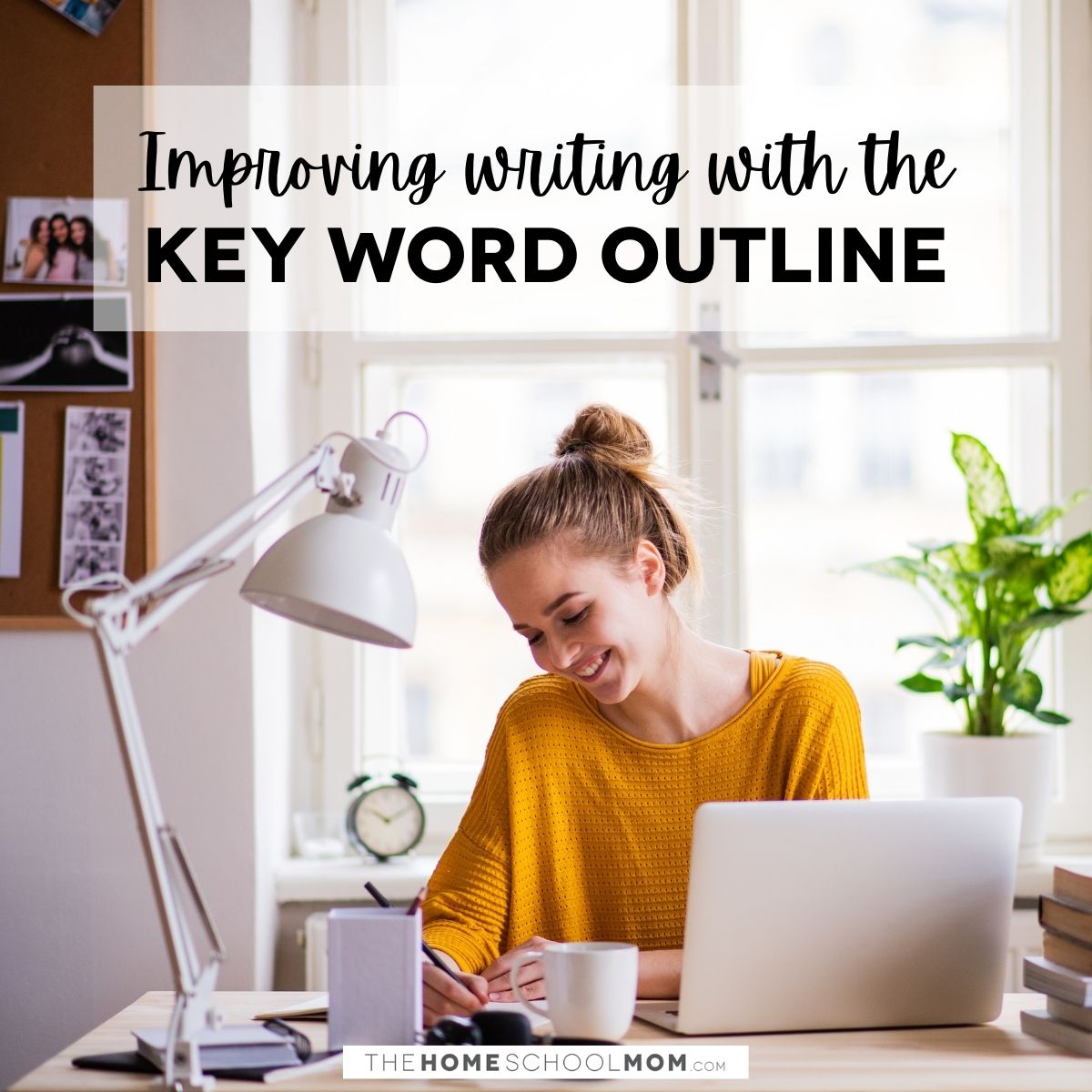Sometimes in homeschooling, it just takes the right tool to make the biggest impact. Well, I've found one that has completely transformed writing for our family.
Writing is often a skill that challenges many students, because even if they have a strong command of grammar, it can be challenging to put words together in a way that is persuasive, interesting, and impactful.
Even worse - many students struggle to summarize from sources when they are doing research, without plagiarizing the original source. Simply understanding source documents can also be daunting for many children, when they are introduced to research writing.
This special little technique I've found? It can help with all of that.
It's called the Key Word Outline.
Jump to:

Although I have been a writer for the majority of my adult life, I never learned about the Key Word Outline until I began teaching writing to my children. I was first introduced to this wonderful tool through the Institute for Excellence in Writing, an incredible, comprehensive homeschool program that effectively teaches students the skills they need to be excellent writers.
Although the program as a whole is, in my opinion, worth every dime of its $200+ price tag, the Key Word Outline is one of its star elements - the framework on which strong writing is built.
Whether your student is just beginning to write, or has been writing for years, the Key Word Outline will help his or her writing improve.
What the Key Word Outline Is
The Key Word Outline involves taking a paragraph and going sentence by sentence to extract from it the words that make up the main idea. Only three words per sentence are allowed, although numbers and symbols are "free" (they don't count as one of the three key words).
The student writes down the key words for each sentence on a separate piece of paper, and then puts away the original paragraph. He then re-writes each sentence in his own words, using only the Key Word Outline as a guide.
Afterward, the student goes back through his sentences and makes them stronger by using more interesting verbs, adjectives, etc., by combining sentences, adding in "ly" words (adverbs), or including other writing "dress-ups".
How to do the Key Word Outline
As an example, here is how a student would do a Key Word Outline on the following sentence:
"The Key Word Outline is a wonderful tool for helping students become strong writers".
The student might choose the following three words as key words from this sentence (although the key words chosen will obviously vary from student to student):
Outline, Tool, Writers
Next, the student would re-write the sentence (not looking at the original), using only her key words:
"A Key Word Outline is a good tool for making good writers".
Then the student would go back over her new sentence, adding in more interesting words, including "ly" words (adverbs), and more interesting nouns, verbs, and adjectives:
"A Key Word Outline serves as a remarkably effective technique for generating exceptional writers".
This same technique would be done for each sentence in the paragraph, and then for multiple paragraphs in a story or body of text.
Why the Key Word Outline is helpful
The Key Word Outline helps children focus on the main idea of each sentence they are reading. This is not only helpful for writing, but for reading comprehension, as well. As children must choose only three words per sentence, they are forced to home in on the most important aspects; less important details are forced to take second stage to the most salient points.
Students can easily find out if they have focused on the main ideas when they attempt to re-write their sentences using only their key words; if they haven't, they will have a difficult time re-writing the sentence (and at that point, they should review the original text and reconsider their choice of key words). Understanding and being able to articulate the main idea of a text is a critical skill all students need to become well-educated, capable adults.
Key Word Outlines also offer students a wonderful framework by which to write in their own words, rather than copying the words of others. The systematic process of starting with just three words, writing a sentence with one's own words, and then adding in more interesting words afterward makes writing simple and doable.
Rather than attempting to tackle a huge portion of text as a whole (which can be overwhelming, especially to the new writer), the Key Word Outline focuses students on one piece at a time, and gives them the tools they need to creatively and effectively write in their own style and with their own words. Creativity can flourish when children transition from the crutch of a provided text to being able to express ideas in their own unique ways.
Finally, the Key Word Outline turns writing into a bit of a scavenger hunt! Instead of writing being a laborious chore, using this tool allows students to make writing into a fun exercise of hunting for excellent words!
The thesaurus should become the child's friend, as he exchanges any boring, dull or common words for exciting, emotional, unique ones. Children's eyes light up as they look up interesting alternatives for well-worn words, such as "articulated" for "said", or "shuffled" for "walked". Obviously, this exercise in acquiring compelling terms is a tremendous boon for students' vocabularies, as well!
So if you or your child has struggled with writing, try the Key Word Outline. Not only will it help your child's reading comprehension and ability to understand and express the main idea of a passage in his or her own words, but it will inspire creativity, develop vocabulary, and turn the process of writing into an exciting game of "Find-a-cool-word"!
Use this tool as the foundation for writing, and you will open up a world of possibilities for your students.




 Rebecca Capuano holds a Master of Social Work degree from East Carolina University and is the stay-at-home mom of three children (one of whom is in heaven). She also makes attempts at being a homeschooler, writer, photographer, scrapbooker, and truth-seeker. She has worked in a variety of capacities (including group homes, day treatment centers, and public schools) with at-risk children and staff, including developing a therapeutic and educational day treatment center for delinquent youth in Wilmington, North Carolina. She currently resides in Virginia. Rebecca believes that family is created by God as the most fundamental institution in society, and she is dedicated to helping families nurture their children to become responsible persons of character and integrity.
Rebecca Capuano holds a Master of Social Work degree from East Carolina University and is the stay-at-home mom of three children (one of whom is in heaven). She also makes attempts at being a homeschooler, writer, photographer, scrapbooker, and truth-seeker. She has worked in a variety of capacities (including group homes, day treatment centers, and public schools) with at-risk children and staff, including developing a therapeutic and educational day treatment center for delinquent youth in Wilmington, North Carolina. She currently resides in Virginia. Rebecca believes that family is created by God as the most fundamental institution in society, and she is dedicated to helping families nurture their children to become responsible persons of character and integrity.
I so appreciate this, Rebecca, thank you! I am a writer by profession, but now serving as a writing/literature teacher for a year, am realizing I've forgotten how to articulate these basic learning concepts. This was so easy to understand. Thank you!
We're glad you found Rebecca's article helpful, Triana!
Dear Rebecca,
I have been blessed with your KWO.Your blog helped me to understand the KWO as a solid foundation and through which any one who wants to start writing he can learn the skill.
Could you suggest me if you have materials to practice writing.
God has blessed you.
Regards
Emmanuel
Hi Emmanuel - As Rebecca mentioned, IEW uses a KWO method in their products. You can find a link to their website in her article.
Hi I will definitely use this in the future , I like this way of showing kids and people that writing can be fun and like a treasure hunt!, I think people will like this new way of key wording.
Glad you have found a new way to think of writing with your kids!
Happy homeschooling!
Jeanne